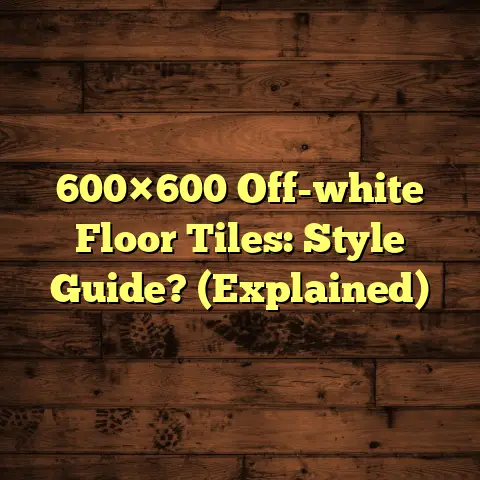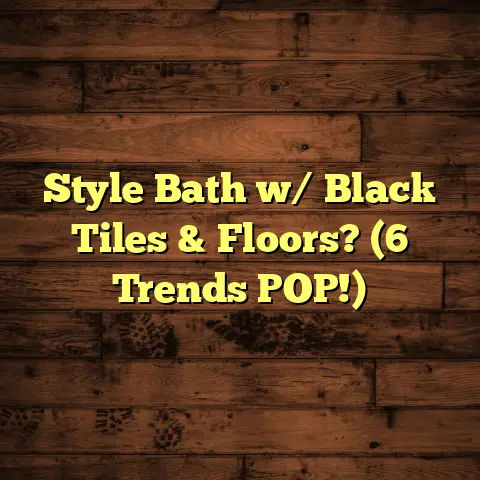Refinishing Hardwood Timeline? (6-Day Pro Breakdown!)
Hardwood isn’t just beautiful; it’s a sustainable choice that brings warmth and elegance to any home. But let’s face it, life happens, and those floors can take a beating. Scratches, dullness, and just plain wear and tear can leave them looking less than their best. That’s where refinishing comes in.
Refinishing your hardwood floors is like giving them a new lease on life. It rejuvenates their look, prolongs their lifespan, and keeps your home looking its absolute best. In this article, I’m going to walk you through a 6-day pro breakdown of the refinishing process. Ready to dive in?
Section 1: Understanding Hardwood Refinishing
So, what exactly is hardwood refinishing? Simply put, it’s the process of sanding down the top layers of your existing hardwood floor to remove any imperfections, then applying new coats of stain and finish to restore its original beauty (or give it a whole new look!).
Think of it like this: your hardwood floor has a protective layer, kind of like the clear coat on your car. Over time, that layer gets scratched, dull, and worn. Refinishing removes that damaged layer and replaces it with a fresh, new one.
But not all hardwood is created equal. There are two main types:
-
Solid Hardwood: Made from a single piece of wood, this is the classic choice and can be refinished multiple times.
-
Engineered Hardwood: Constructed with a thin layer of hardwood on top of a plywood or fiberboard core. This type can only be refinished a limited number of times, depending on the thickness of that top layer.
Why do homeowners choose to refinish their floors? I’ve seen it all! Here are some common reasons:
-
Scratches and Dents: The most obvious reason. Pets, kids, furniture – they all take a toll.
-
Dullness: Over time, the finish on your floors can lose its luster, making the entire room look drab.
-
Changing Styles: Maybe you’re tired of the current color, or it no longer matches your decor.
-
Preparing to Sell: Refinishing is a great way to boost your home’s value and appeal to potential buyers.
Section 2: The 6-Day Refinishing Timeline Overview
Okay, let’s get to the heart of the matter: the 6-day refinishing timeline. Now, I want to be clear: this is a PRO timeline. It’s designed for professionals who have the right tools, experience, and a structured approach. This isn’t a weekend DIY project!
Here’s a quick overview of what we’ll cover:
-
Day 1: Preparation: Getting the room ready for the sanding and finishing process.
-
Day 2: Sanding: The most labor-intensive part, removing the old finish and smoothing the wood.
-
Day 3: Staining: Applying the stain to achieve your desired color.
-
Day 4: Sealing: Protecting the wood and providing a base for the final finish.
-
Day 5: Finishing: Applying the final coats of finish for durability and shine.
-
Day 6: Final Touches and Cleanup: Inspecting the floor, replacing trim, and cleaning up the mess.
Remember, this is a general timeline. Drying times and the number of coats needed can vary depending on the products you use and the humidity levels in your home. Always follow the manufacturer’s instructions!
Section 3: Day 1 – Preparation
Alright, let’s kick things off with Day 1: Preparation. This is arguably the most crucial step. A poorly prepared floor will lead to a poor refinishing job, no matter how skilled you are.
Here’s what you need to do:
-
Clearing the Area: This means EVERYTHING. Furniture, rugs, curtains, lamps – get it all out of the room. Trust me, you don’t want dust getting into your belongings.
-
Inspecting the Floor: Take a good, hard look at your floor. Are there any loose boards? Deep scratches? Water damage? Now’s the time to address these issues. Replacing damaged boards is essential before you start sanding.
-
Cleaning the Floor: Vacuum the floor thoroughly to remove any loose dirt and debris. Then, use a damp cloth (not soaking wet!) to wipe down the surface. You want to remove any lingering grime that could clog your sandpaper.
I can’t stress enough the importance of proper ventilation and safety measures during this phase (and throughout the entire process, really). Open windows and doors to allow for airflow. Wear a respirator mask to protect your lungs from dust and fumes. And don’t forget safety glasses to protect your eyes! I always tell my crew, “Safety first, refinishing second!”
Section 4: Day 2 – Sanding
Okay, folks, buckle up! Day 2 is all about sanding. This is where the magic happens, but it’s also where the real work begins. Sanding removes the old finish, levels the floor, and prepares it for staining and sealing.
There are two main types of sanders you’ll encounter:
-
Drum Sander: This is the big kahuna, used for the main part of the floor. It’s powerful and aggressive, so you need to be careful not to gouge the wood.
-
Orbital Sander: This is used for the edges and corners, where the drum sander can’t reach. It’s less aggressive and easier to control.
The type of wood you have will also influence your choice of sander and grit progression. Softer woods like pine require a lighter touch than harder woods like oak.
Speaking of grit progression, what is that? It’s the process of using progressively finer grits of sandpaper to gradually smooth the floor. I usually start with a coarse grit (like 36 or 40) to remove the old finish, then move to a medium grit (like 60 or 80) to level the floor, and finally finish with a fine grit (like 100 or 120) to create a smooth surface.
Why does grit progression matter? If you skip grits, you’ll end up with scratches that will be visible even after you stain and finish.
Dust control is also critical during sanding. Use a sander with a dust collection system, and seal off the room with plastic sheeting to prevent dust from spreading to other areas of your home. After each sanding pass, vacuum the floor thoroughly to remove all the dust.
I remember one time, I was refinishing a floor in an old Victorian house. The homeowner insisted on keeping all the windows open for ventilation, even though it was a windy day. Let’s just say the dust got EVERYWHERE! It took me hours to clean up the mess. Lesson learned: control the environment as much as possible!
Section 5: Day 3 – Staining
Alright, Day 3 is where you start to see the real transformation! Staining is all about adding color and personality to your floors.
Choosing the right stain color is crucial. Think about the overall style of your home, the color of your furniture, and the amount of natural light in the room. Darker stains can make a room feel cozier, while lighter stains can make it feel more open and airy.
Before you commit to a stain color, test it on a small, inconspicuous area of the floor. This will give you a better idea of how the stain will look once it’s dry.
There are several ways to apply stain:
-
Brushes: Good for detail work and getting into corners.
-
Rollers: Faster for covering large areas.
-
Rags: My personal favorite. They allow you to control the amount of stain you apply and create a more even finish.
Regardless of the method you choose, apply the stain in the direction of the wood grain. Work in small sections and wipe off any excess stain with a clean rag.
Drying time is crucial for stain. Follow the manufacturer’s instructions, but generally, you’ll want to let the stain dry for at least 24 hours before moving on to the next step. Keep in mind that humidity can affect drying time.
Section 6: Day 4 – Sealing
Day 4 is all about sealing. Sealer is like a primer for your floors. It protects the wood from moisture, prevents the stain from bleeding, and provides a smooth base for the final finish.
There are two main types of sealers:
-
Oil-Based Sealers: These provide a durable, water-resistant finish. They tend to amber over time, adding warmth to the floor.
-
Water-Based Sealers: These are low-VOC (volatile organic compounds), meaning they’re more environmentally friendly. They dry faster than oil-based sealers and don’t amber as much.
The application method is similar to staining. Use a brush, roller, or rag to apply a thin, even coat of sealer in the direction of the wood grain. Allow the sealer to dry completely before applying the next coat.
I always recommend applying at least two coats of sealer for maximum protection. And remember, proper drying time between coats is essential. Don’t rush the process!
Section 7: Day 5 – Finishing
We’re almost there! Day 5 is all about the finish. The finish is the top layer of protection for your floors. It provides durability, scratch resistance, and that beautiful shine we all love.
There are several types of finishes available, each with its own pros and cons:
-
Polyurethane: The most common type of finish. It’s durable, water-resistant, and available in a variety of sheens (glossy, semi-gloss, satin, matte).
-
Water-Based Polyurethane: Similar to polyurethane, but with lower VOCs.
-
Moisture-Cured Urethane: A very durable finish that’s often used in commercial settings.
-
Penetrating Oil Finish: A natural finish that penetrates the wood, providing a matte look.
As with staining and sealing, apply the finish in thin, even coats in the direction of the wood grain. Use a brush, roller, or applicator pad.
The number of coats you apply will depend on the type of finish you use and the level of protection you want. I typically recommend at least two coats of finish, but three is even better.
Drying and curing times are critical for the finish. Follow the manufacturer’s instructions carefully. Generally, you’ll want to wait at least 24 hours between coats and allow the floor to cure for several days before moving furniture back into the room.
Section 8: Day 6 – Final Touches and Cleanup
Congratulations! You’ve made it to Day 6: Final Touches and Cleanup. This is where you put the finishing touches on your masterpiece and get your home back in order.
-
Inspect the Floor: Take a close look at the floor for any imperfections. Are there any drips, bubbles, or uneven areas? If so, you may need to lightly sand the affected area and apply another coat of finish.
-
Replace Baseboards or Trim: If you removed the baseboards or trim before refinishing, now’s the time to put them back on.
-
Thorough Cleanup: Vacuum the floor thoroughly to remove any dust or debris. Then, use a damp cloth to wipe down the surface.
-
Curing Time: This is the hardest part. I know you’re excited to get your furniture back in the room, but it’s crucial to let the floor cure properly before doing so. This will ensure that the finish hardens completely and is resistant to scratches and dents. I generally recommend waiting at least 72 hours before moving furniture back into the room, and even longer if possible.
I always tell my clients, “Patience is a virtue when it comes to refinishing floors!”
Conclusion
So, there you have it: a 6-day pro breakdown of the hardwood refinishing timeline. It’s a lot of work, but the results are well worth it.
Refinishing your hardwood floors is a great way to enhance the beauty and longevity of your home. It’s an investment that will pay off in terms of both aesthetics and property value.
Remember, with proper planning and execution, you can achieve professional-looking results that contribute to a smart living environment. So, consider refinishing as a valuable part of your home maintenance routine, ensuring that your living spaces remain functional, stylish, and sustainable.
Happy refinishing!
Glossary of Terms:
-
Hardwood: Wood from deciduous trees (trees that lose their leaves annually).
-
Engineered Hardwood: Flooring made of a thin layer of hardwood bonded to a plywood or fiberboard core.
-
Grit: A measure of the size of abrasive particles on sandpaper. Lower numbers indicate coarser grits, while higher numbers indicate finer grits.
-
Stain: A colored liquid used to add color to wood.
-
Sealer: A clear liquid used to protect wood and provide a base for the finish.
-
Finish: A clear liquid used to protect wood and provide a durable, scratch-resistant surface.
-
Polyurethane: A type of finish that is durable and water-resistant.
-
VOC (Volatile Organic Compounds): Chemicals that evaporate at room temperature and can be harmful to human health.
-
Curing Time: The time it takes for a finish to harden completely.
-
Sheen: The degree of glossiness of a finish.





